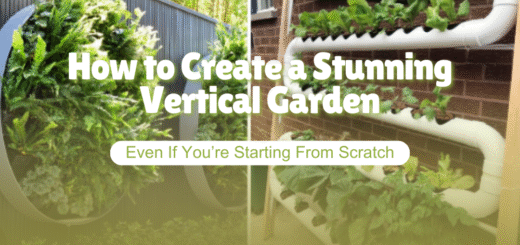Sky-High Veggies: How to Grow a Vertical Vegetable Garden (No Farm Needed)
Not everyone has a sprawling backyard for rows of tomatoes and corn. But guess what? You don’t need one. With a little creativity and some upward thinking, even a fire escape or balcony railing can become a productive veggie patch. The secret? Grow vertically.
I’ve turned tiny urban spaces into edible jungles for years, and these are the crops that consistently outperform the rest when grown on trellises, in stacked planters, or even repurposed rain gutters. No fluff, just the good stuff.
10 Vegetables That Thrive in Vertical Gardens
1. Pole Beans: The Overachievers
Forget bush beans—pole varieties like ‘Scarlet Runner’ or ‘Kentucky Wonder’ climb like crazy, producing buckets of beans in tight spaces.
- How to grow: Train them up a trellis, bamboo teepee, or even a string grid.
- Pro tip: Pick beans young and often to keep them coming.
2. Peas: Sweet, Fast, and Effortless
Sugar snaps and snow peas practically want to grow vertically. Their delicate tendrils cling to anything, and they’re one of the first crops you can plant in spring.
- Trick: Soak seeds overnight before planting for quicker sprouting.
- Bonus: They add nitrogen to the soil, making them great neighbors for heavy feeders like lettuce.
3. Cucumbers: The Trellis Champions
Vining cucumbers (like ‘Straight Eight’ or ‘Lemon Cucumber’) are way happier climbing than sprawling. Plus, hanging cukes grow straighter and stay cleaner.
- Must-do: Use a sturdy trellis—those fruits get heavy!
- Avoid: Letting them flop on the ground (hello, rot and pests).
4. Tomatoes: Yes, Even in Small Spaces
Not all tomatoes are created equal. Skip the beefsteaks and go for determinate varieties (like ‘Roma’ or ‘Tumbling Tom’) that stay compact but still pump out fruit.
- Support needed: Cages, stakes, or a heavy-duty trellis.
- Game-changer: Prune suckers to focus energy on fruit, not leaves.
5. Leafy Greens: Cut-and-Come-Again Salads
Lettuce, spinach, and kale don’t need depth—just consistent moisture and a little shade in hot weather.
- Best for: Hanging planters or tiered shelves.
- Harvest hack: Snip outer leaves, and they’ll regrow all season.
6. Peppers: Compact but Mighty
Small-fruited peppers (like jalapeños or shishitos) do great in containers and don’t mind being a little root-bound.
- Key: Give them heat—black pots or a sunny wall to bounce warmth onto them.
- Pick often: The more you harvest, the more they produce.
7. Radishes: The Instant Gratification Crop
From seed to snack in three weeks. Perfect for impatient gardeners (or kids).
- Grow them in: Shallow trays or even repurposed rain gutters.
- Secret: Keep soil moist, or they’ll turn woody and spicy.
8. Strawberries: Sweetness on a String
Alpine or everbearing strawberries thrive in vertical pockets, hanging bags, or stacked towers.
- Why vertical? Keeps fruit off the ground (no slugs, no rot).
- Feed them: A little compost tea every few weeks for sweeter berries.
9. Herbs: Flavor That Fits Anywhere
Basil, thyme, oregano, and chives don’t need much room—just sunlight and a trim now and then.
- Best setup: Wall-mounted pockets or a repurposed shoe organizer.
- Pro move: Plant basil near tomatoes (they’re best friends).
10. Zucchini & Summer Squash: Yes, Really
Bush varieties (like ‘Patio Star’) stay small but still pump out squash. Train them up a trellis to save space.
- Warning: They’re thirsty—mulch well to keep soil moist.
The No-BS Guide to Vertical Success
1. Pick the Right Structure
- Trellises: Best for climbers (beans, peas, cukes).
- Stacked planters: Ideal for greens, herbs, and radishes.
- Hanging baskets: Perfect for strawberries and trailing tomatoes.
2. Soil Matters More Than You Think
- Use lightweight potting mix (not garden soil—it’s too dense).
- Add compost for nutrients and perlite for drainage.
3. Watering: The Make-or-Break Factor
- Vertical gardens dry out fast. Drip irrigation or self-watering planters save time.
- Test: Stick your finger in the soil—if it’s dry an inch down, water.
4. Feed Like You Mean It
- Liquid seaweed or fish emulsion every 2 weeks keeps plants happy.
- Avoid heavy fertilizers—they can burn roots in tight spaces.
5. Harvest Early, Harvest Often
- Most veggies (beans, lettuce, cukes) produce more when picked regularly.
- Letting things go to seed = game over for new growth.
Final Thought: Start Small, Think Up
You don’t need a fancy setup to grow food vertically. A $5 trellis, some recycled containers, and a handful of seeds are all it takes. Pick 2-3 crops to start, nail the basics, and expand from there. Before you know it, you’ll be snacking on homegrown beans while your neighbors wonder how you did it.


